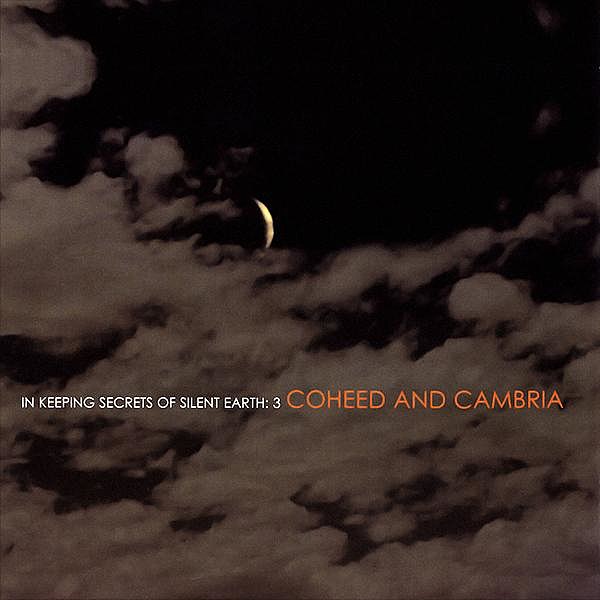
So Grim, So True, So Real: Coheed and Cambria

…
So Grim, So True, So Real offers dynamic insights into the discographies of storied bands through a three-tiered lens. First, the worst album. Second, the best album, based on our read of the dominating public opinion. And third, the “realest” album, the one that sets the writer’s heart ablaze, all other considerations be damned.
…
Coheed and Cambria is my favorite band — above all other bands, I love them the most. They’re one of the few bands whose discographies I’ve internalized to the point that I feel qualified enough to tackle their discography for this huge reboot of So Grim, So True, So Real.
Since their 2002 debut full-length The Second Stage Turbine Blade, and excepting 2015’s The Color Before the Sun, the band has been singularly focused on the telling of The Amory Wars, a star- and time-spanning science fiction and often semi-autobiographical saga set in space amongst the planets of Heaven’s Fence. Vocalist and guitarist Claudio Sanchez channels his stories through opaque lyrics that accompany the band’s stylistically diverse music, ranging from the emo-tinged progressive post-hardcore of the aforementioned debut to sprawling Rush-esque epics.
Coheed and Cambria offer toppling heaviness and poignant vulnerability in their music, and no matter what far-flung influences or varieties in execution they employ, there is always something undeniably “Coheed and Cambria” imprinted on each of their songs. The band stitches together elements most artists might view as incompatible; they relentlessly inject genuine emotional reckoning into their music that often finds itself in the realms of the overwrought and over-the-top.
Wielding a disarming, arrestingly reedy voice with remarkable control and power, Sanchez displays real awareness of its effect and presence — the Coheed and Cambria sound is also in drummer Josh Eppard’s unyielding enthusiasm and ability to carry his bandmates’ stilted single-note riffs through transitions into full-on chordal walls. It’s in the immense musicianship of guitarist Travis Stever, original bassist Mic Todd, and current bassist Zach Cooper in making the measured and precise contributions to elevate the songs without leaving them wanting for more or pushing them into oversaturation.
The band, on paper, sounds so ridiculous — heavy prog-pop songs with lyrics about space wars and romances delivered via cartoonishly high singing — but has in reality given me one of the most gripping and charismatic long-term artistic endeavors I’ve ever experienced. Coheed and Cambria have enjoyed consistent success while bolstering one of the most passionate and dedicated fanbases in rock music. There’s a real love for this band from their fans, and it’s reciprocated every time they perform live.
And now, the grimmest, truest, and realest Coheed and Cambria albums of them all.
…
So Grim: The Afterman: Ascension (2012) + The Afterman: Descension (2013)

Choosing Coheed and Cambria’s grimmest moment was never going to be about fingering a bad album out of their lineup. When evaluating a band this consistent, the task becomes one of identifying the least-great moment in a history of standout excellence. If glaring flaws don’t exist at all, nitpicking becomes a necessity. And with the The Afterman double album, the choice boils down to one weakness: bloat. It’s the only record that, at least for me, contains skippable tracks, even if looking at its halves as individual albums. It’s on that basis that I’m identifying it as the grimmest Coheed and Cambria release.
For every outstanding “Domino,” there’s a “Holly Wood” — a serviceable-enough song, but one that falls flat when stacked up against the band’s other material. “Goodnight, Fair Lady” is as solid a pop-punk bop as any other, but when viewed in the context of “Blood Red Summer” and “The Suffering,” its minuscule shortcomings become a bit more apparent.
…
…
The Afterman is the least essential in terms of its role in The Amory Wars. Coheed and Cambria charted a course similar to Peter Jackson’s in his The Hobbit trilogy, i.e. packing a glut of superfluous content into a setup story that could be told, as effectively, in a fraction of the time.
The album delves into the Keywork, an energy lattice linking the planets that together make up Heaven’s Fence — scientist Sirius Amory (namesake of the band’s chronicle) ventures into the Keywork to realize that it’s not made of light energy after all, but in fact comprises all the souls of those who have lived and died in Heaven’s Fence. We follow Sirius as he interacts with five of these souls — whose respective tales, while compelling, aren’t essential to the overall worldbuilding efforts of the prequel — and then returns home to venture through his own share of personal catastrophes in the wake of his years-long journey.
While this journey is one worth exploring, the album’s primary contribution to The Amory Wars isn’t the specifics of Sirius’s individual story, tragic as it is, so much as his discovery of the Keywork’s true composition.
…
…
I appreciate the risks taken on this record with a song like “Number City,” even if it’s not always what I’m after when I spin up one of their records. The intro bass riff from the then-new Cooper is immediately engaging, especially as it inverts with the addition of Eppard’s kick drum placement. When those horns hit, it’s an effect similar to that in Clutch’s “In Walks Barbarella” — instant jaw-drop — and the track boasts one of the album’s most infectious choruses. Even when Coheed and Cambria stray from the path, they always return.
Despite a few flat numbers, The Afterman contains many more redeeming moments than sour ones. “Key Entity Extraction I: Domino the Destitute,” “Key Entity Extraction V: Sentry the Defiant,” and “Gravity’s Union” would have no trouble earning inclusion in a list of the band’s strongest songs. And The Afterman: Descension’s final trio of songs is a heart-aching crescendo of emotional intensity resulting in one of the most powerful closing sequences in Coheed and Cambria’s discography.
…
So True: Good Apollo, I’m Burning Star IV, Volume One: From Fear Through the Eyes of Madness (2005)

Good Apollo, I’m Burning Star IV, Volume One: From Fear Through the Eyes of Madness — or Good Apollo for short — is Coheed and Cambria’s third record and represents their official arrival into widespread renown (while not quite into the mainstream consciousness). On the back of their previous record In Keeping Secrets of Silent Earth: 3, the band signed with Columbia to release what would become their second certified gold record, along with its predecessor.
Not since Good Apollo has a Coheed and Cambria album seen such numbers.
…
…
There’s an undeniable maturity that pervades Good Apollo, fitting for a band hot off the buzz of a critically acclaimed sophomore release and a live DVD working on their major label debut. The album cements their songwriting tradition of echoing lyrical and narrative themes with musical cues and references, e.g. the callbacks within “The Willing Well III: Apollo II: The Telling Truth” to “Apollo I: The Writing Writer,” In Keeping Secrets of Silent Earth: 3‘s “Blood Red Summer,” and even back two albums to reference “Everything Evil” from The Second Stage Turbine Blade. Good Apollo is a true concept album in this sense, looping musically around on itself and to prior albums while the band, and the album’s fictional narrator, recall moments from earlier in the story.
Good Apollo builds off the emo-inflected post-hardcore of In Keeping Secrets of Silent Earth: 3 and The Second Stage Turbine Blade, and while the former marked Coheed and Cambria’s initial forays into the prog epics that would come to characterize their sound, Good Apollo internalized that approach and elevated it to an equal component in the list of ingredients while also refining the band’s original stylistic roots. It’s also the home of their most accomplished ballad, the beloved “Wake Up,” which along with “The Suffering” centerpieces the album as a whole.
From start to finish, Good Apollo is an evolution of the capacity for grandeur that Coheed and Cambria hinted at on their debut and fully explored on their second album, nudging the unrestrained power-emo-pop of their earlier work into higher tiers of sophistication. The second track “Welcome Home” persists as the group’s heaviest moment ever and is a resolute and oft-cited signpost in characterizing their sound. Along with album closer “The Willing Well IV: The Final Cut,” it’s the model, though not the origin, for their brand of prog epicness to which they’d return time and time again throughout their career.
Story-wise, Good Apollo takes a meta-step back to look at Ryder, the (also fictional) Writer-with-a-capital-W of the Amory Wars saga, and how events in his life shape the decisions he makes with regard to the characters of Heaven’s Fence (at the behest of Ten Speed, a demonic bicycle), and eventually, how the two intersect. You’ve got Claudio (Sanchez, the real-world human and creator of The Amory Wars), then Ryder the Writing Writer within the “real world” of Sanchez’s mythology — termed in-universe as “The Real” — plus Claudio the Character, protagonist of the Amory Wars story. The “Good Apollo” in the album’s title refers to a dog in whom Character-Claudio confides, and who is owned in the story by his ex-girlfriend.
It’s a lot.
Just as Good Apollo is a big step up in an industry sense, it is also bolder, more ambitious, and wider-reaching than either of their previous efforts. And its sequel, while similarly large in scale, doesn’t quite meet the precedent Good Apollo sets. Coheed and Cambria were absolutely fearless on this one, and that fearlessness is married with the confidence of a solid original lineup that hadn’t quite yet begun to significantly deteriorate. Together, these elements combine to produce a master opus that, despite the strength of all that’d come after it, the band has yet to surpass.
Writing about Good Apollo in the above capacity has been the most challenging part of this piece — not because I don’t love it (I do, immensely), but because I don’t love it quite as passionately as its two predecessors. And between them, there’s only one that I can consider so real.
…
So Real: In Keeping Secrets of Silent Earth: 3 (2003)

This is it. The nexus of All Things Coheed, the creative cauldron in which all subsequent albums have stewed.
In Keeping Secrets of Silent Earth: 3 is not Coheed and Cambria’s first record, but it is the official birthing of their defining sound and the blueprint for what they would become. While Good Apollo marked the band’s major label debut with Columbia, In Keeping Secrets of Silent Earth: 3 is the record that made that leap possible.
In Keeping Secrets of Silent Earth: 3 straddles The Second Stage Turbine Blade and Good Apollo by maintaining the exuberance of the former while opening the door toward the grandiosity of the latter. The maturity of Good Apollo came at the muffling of the youthful fervor which fuels its predecessors, but this ebullience is refined on In Keeping Secrets of Silent Earth: 3 by the band’s rising progressive tendencies and long-form vision.
The album is very much the work of a fiery young group, but one who have begun steering their energy away from the raw expression of their debut towards higher conceptual work.
…
…
The title track is the band’s iconic epic, unfolding and swelling, contracting to the barest whisper, exploding again, rising ever higher from one zenith to the next. It’s impossible to hear the mournful opening notes and not feel humbled at the knowledge that your journey is just beginning — the song overflows with sheer purpose, fitting for its story of the first battle between a wrathful general and the insurgent leader. While as a single, “In Keeping Secrets of Silent Earth: 3” fell comparatively flat next to the two others from the record — “A Favor House Atlantic” and “Blood Red Summer” — it’s remained a consistent fan favorite over the years, and it’s also my most-loved Coheed and Cambria song.
Even if you’re not engaged with the Amory Wars story at all, the band’s work more than holds up without it. You wouldn’t be alone — Sanchez’s lyrics, especially on the earlier records, are inscrutable far more often than not, filled with unexplained in-universe references and undeclared changes in perspective from one character to the next, and regularly serving double duty as autobiographical commentary. Unless you’re listening along with the corresponding comics in front of you, and even then, it’s no small feat to figure out what’s happening or who’s or saying what to whom. But you don’t need that context in order to viscerally experience the music’s emotional weight.
When Sanchez wails “Man your own jackhammer!” in the title track’s chorus, the urgency is palpable, regardless of whether or not you have any idea what he’s talking about (and if you’re wondering, jackhammers are a type of combat ship). When the band drapes the morbid “Pull the trigger and the nightmare stops” lyric over the jubilant final passage of “Three Evils (Embodied in Love and Shadow),” the dissonance is shattering. The marriage of unambiguously disquieting lyrics with triumphant and tender music is a device that Coheed and Cambria deploy to chilling effect throughout their catalogue, multiplied many times over when contextualized in the Amory Wars’ calamitous events and twisted characters.
In addition to the sprawling nature of the title track, Coheed and Cambria experiment with an assortment of other songwriting structures and styles. “Three Evils (Embodied in Love and Shadow)” is essentially a giant crescendo in structure from beginning to end — it’s the “terminal climax” as coined by music theorist Brad Osborn, and an approach used extensively on The Second Stage Turbine Blade but one that hasn’t remained as much of a staple on later releases. And there’d be no “Wake Up” without the first few minutes of penultimate track “The Light & the Glass.”
If “In Keeping Secrets of Silent Earth: 3” is the prototypical Coheed and Cambria epic, so is “Blood Red Summer” their defining pop song and “A Favor House Atlantic” their quintessential power anthem. Both of these can in turn reach backward for their respective geneses, but the archetypes don’t fully coalesce until In Keeping Secrets of Silent Earth: 3. Together, they contain the building blocks for the six albums (counting The Afterman as one) that would follow — it feels almost prophetic that these three songs were selected as singles to serve as the vanguard of the record.
While Good Apollo represents Coheed and Cambria at their most purposeful and refined, In Keeping Secrets of Silent Earth: 3 is both the fire in which that album is forged as well as the naked elements that form its skeleton. And it’s for this reason, because of how it preserves the exposed heart of the band, bereft of pretense yet containing so much promise and emotional consequence, that In Keeping Secrets of Silent Earth: 3 is so, so real.
…
Support Invisible Oranges on Patreon and check out our merch.
…










